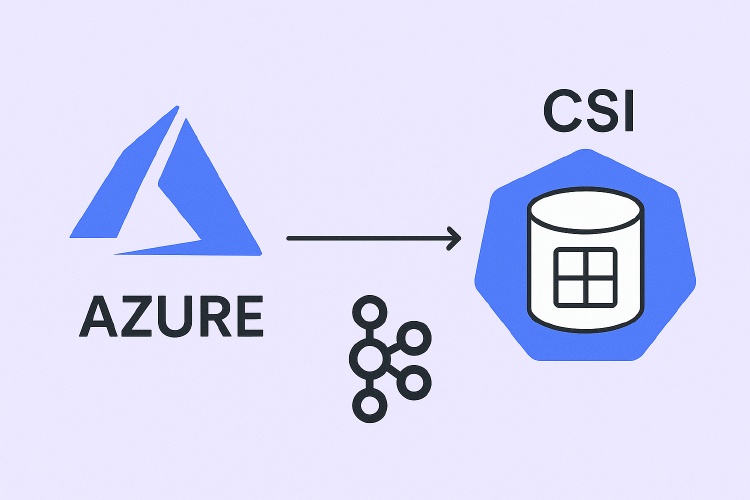Getting Started with CSI on Azure Kubernetes Service
A comprehensive, practical guide to deploying and using the Azure Disk CSI driver in AKS.

- Dr. Vivek Shilimkar
- 3 min read

Introduction
The Container Storage Interface (CSI) is now the industry standard for connecting Kubernetes clusters to a variety of storage solutions. Whether you’re launching a new workload or modernizing an existing deployment, understanding how to leverage CSI is essential. This article provides a hands-on walkthrough for deploying the Azure Disk CSI driver on Azure Kubernetes Service (AKS), combining both conceptual background and practical steps.
Why CSI?
CSI provides a unified way to integrate Kubernetes with different storage backends, making it easier to manage persistent storage for your applications. Official CSI drivers are maintained by the Kubernetes community and cloud providers, ensuring robust support for cloud-native workloads.
Prerequisites
Before proceeding, ensure the following:
- Your AKS cluster is running a recent Kubernetes version
- You have cluster-admin rights
- Network connectivity between your nodes and Azure storage endpoints is healthy
Installing the Azure Disk CSI Driver
Azure’s CSI driver can be installed directly using a deployment script. The following command will fetch and install version v1.30.3 (check for the latest version before running):
curl -skSL https://raw.githubusercontent.com/kubernetes-sigs/azuredisk-csi-driver/v1.30.3/deploy/install-driver.sh | bash -s v1.30.3 snapshot –
This script deploys the necessary controller and node components to your cluster.
Verifying the Deployment
Once installation is complete, confirm that the driver pods are up and running:
kubectl get pods -n kube-system -l app=csi-azuredisk
You should see both node and controller pods in the Running state. Example output:
NAME READY STATUS RESTARTS AGE
csi-azuredisknode-xyz12 3/3 Running 0 5m
csi-azuredisknode-abcd3 3/3 Running 0 5m
csi-azuredisknode-pqrs9 3/3 Running 0 5m
csi-azurediskctrl-0 5/5 Running 0 5m
csi-azurediskctrl-1 5/5 Running 0 5m
Defining a StorageClass
To enable dynamic provisioning, create a StorageClass that references the Azure Disk CSI driver. Save the following as aks-disk-storageclass.yaml:
apiVersion: storage.k8s.io/v1
kind: StorageClass
metadata:
name: aks-disk-storageclass
provisioner: disk.csi.azure.com
parameters:
skuname: Standard_LRS
kind: Managed
reclaimPolicy: Delete
volumeBindingMode: Immediate
Apply it with:
kubectl apply -f aks-disk-storageclass.yaml
Requesting Persistent Storage
Next, create a PersistentVolumeClaim (PVC) to request storage from the above StorageClass. Save as aks-disk-pvc.yaml:
apiVersion: v1
kind: PersistentVolumeClaim
metadata:
name: aks-disk-pvc
spec:
accessModes:
- ReadWriteOnce
storageClassName: aks-disk-storageclass
resources:
requests:
storage: 50Gi
Apply the PVC:
kubectl apply -f aks-disk-pvc.yaml
Using the PVC in Your Application
To mount the provisioned disk in a pod, reference the PVC in your deployment spec. Here’s an example snippet:
spec:
containers:
- name: web
image: nginx:latest
ports:
- containerPort: 80
volumeMounts:
- mountPath: /usr/share/nginx/html
name: aks-disk-volume
volumes:
- name: aks-disk-volume
persistentVolumeClaim:
claimName: aks-disk-pvc
With this setup, your application will have access to persistent storage, ensuring data durability even if pods are rescheduled or replaced.
Additional Notes
- Make sure you are using the latest supported version of the Azure Disk CSI driver for your Kubernetes version.
- You can customize the StorageClass parameters (such as
skunameandkind) to match your performance and cost requirements. - For advanced scenarios, such as using snapshots or resizing volumes, refer to the official Azure CSI documentation.
Conclusion
By following these steps, you’ve enabled robust, cloud-native storage for your AKS workloads using the Azure Disk CSI driver. This unified approach ensures your Kubernetes applications can reliably consume persistent storage on Azure.
- Tags:
- Azure
- Kubernetes
- CSI
- Storage